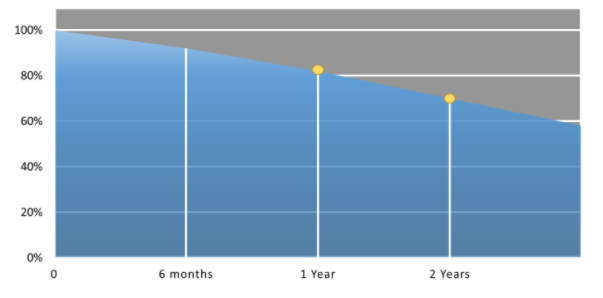Warranty
We at BlitzWolf believe in the quality of our products and are confident that our products will serve their owners for a long time, even with intensive daily use. If, despite proper operation, a product fails, the replacement or repair is completely free of charge.
What is the warranty on my Blitzwolf product?
14-day satisfaction guarantee.
BlitzWolf is committed to providing a customer experience, so if for any reason you are not completely satisfied with what you received, you can return it to us and we will refund your purchase price. (except for hygiene products) To exercise your right of withdrawal, please fill out our withdrawal form.
Guarantee for quality issues.
The duration of the mandatory warranty
a) two years for a sales price of HUF 10,000 but not exceeding HUF 250,000,
b) three years for a sales price of HUF 250,000 or more.
Remember: it's easy to get used to good things, once you've purchased a BlitzWolf product, you won't choose another brand next time!
If you're still dissatisfied with the product, fill out our complaint handling form.
Please note that we can only initiate warranty administration for products purchased from us.
Battery Life Cycle
- Due to the chemical properties of lithium-ion, the battery capacity gradually decreases over time during use. This is normal.
- The life of a Li-ion battery is approximately 300-500 charge cycles. Under normal usage conditions and ambient temperature (25℃), it can generally be used for 300 discharge-charge cycles (or about one year). After that, the battery capacity will drop to 80% of its original value.
- The reduction in battery life depends on the product structure, model, and power consumption. High/low operating temperatures and abnormal operations can result in a 60% or faster reduction in battery life in a short period of time.

Battery Protection Mechanisms
Regularly charging batteries at high voltages accelerates their aging. In order to extend the battery life, if the battery remains at a charge level of 90-100% after being fully charged, the system will not recharge it for protection.
* The battery’s charge start capacity is usually set between 90 and 99%. The actual value varies depending on the model.
Batteries charged or stored at high ambient temperatures may permanently lose capacity and accelerate the shortening of the battery’s lifespan. If the battery temperature is too high or overheats, the battery’s charging capacity may be limited or even stop charging. This is one of the system’s battery protection mechanisms.
Battery Aging
Li-ion batteries naturally wear out and lose capacity over time due to continuous chemical reactions.
The battery may swell somewhat after a period of use and under certain conditions. This is not a safety concern.
Swollen batteries should be replaced and disposed of properly, although they do not pose a safety risk. When replacing swollen batteries, do not dispose of the old battery in the general household waste.
Standard Battery Precautions
If you will not be using a device for a long time, charge the battery to approximately 50%, turn off the device, and disconnect the AC power supply (adapter). Charge the battery to 50% every three months to prevent battery damage from over-discharge and long-term storage without use.
If you are using AC power continuously, you should discharge the battery to 50% at least once every two weeks to remove the battery from the constant high voltage that can shorten the battery life.
The best storage conditions for the battery are: 10° C - 35 °C (50 °F - 95 °F) ambient temperature, 50% charge level.
Do not store batteries in a humid environment, as this can accelerate their discharge. Temperatures that are too low will damage the internal chemicals of the battery, while batteries that are too high may explode.
Do not place your device near radiators, fireplaces, stoves, electric heaters or other heat sources with a heat source above 60 ℃ (140 °F). The battery may explode or leak if it overheats, which is a fire hazard.
Never let the battery completely discharge. Some products (such as remote control toys) do not have electronics to prevent overdischarge, so leaving the device turned on can destroy the battery in just a few hours. Overdischarge can be determined by measuring the terminal voltage of the battery. A value below 2.9 volts for a 1-cell, 3.7-volt battery, below 6.5 volts for a 2-cell 7.4-volt battery (etc.) means the battery is overdischarged and cannot be replaced under warranty. In this case, the battery is permanently damaged, cannot be charged (it charges indefinitely when plugged into a charger), so it is treated as hazardous waste.
BlitzWolf battery warranty rules
BlitzWolf provides a warranty for the battery as follows:
If the device becomes unbootable, restarts/shuts down on its own or loses power irregularly during the battery warranty period, we will replace the battery.
If during the battery warranty period the battery does not hold a charge, the system does not detect the battery, continuously indicates this or says "Please charge the battery", or the charging light flashes incorrectly (i.e. the battery is not charging properly), we will replace the battery.
The following are not covered by the warranty:
Reduced capacity due to normal wear and tear.
Failure or damage caused by repairs, disassembly and reassembly by the original manufacturer or by unauthorized specification changes, or by the use of non-original manufacturer parts.
Moisture has damaged the internal battery wiring/connectors, or the electronic components have been severely oxidized and corroded due to liquid leakage.
Failure caused by overdischarge (For a 1-cell, 3.7 volt battery, 2.9 volts terminal voltage measured below, for a 2-cell 7.4 volt battery, a terminal voltage value measured below 6.5 volts (etc.) indicates that the battery is overcharged)
Other irregular uses
